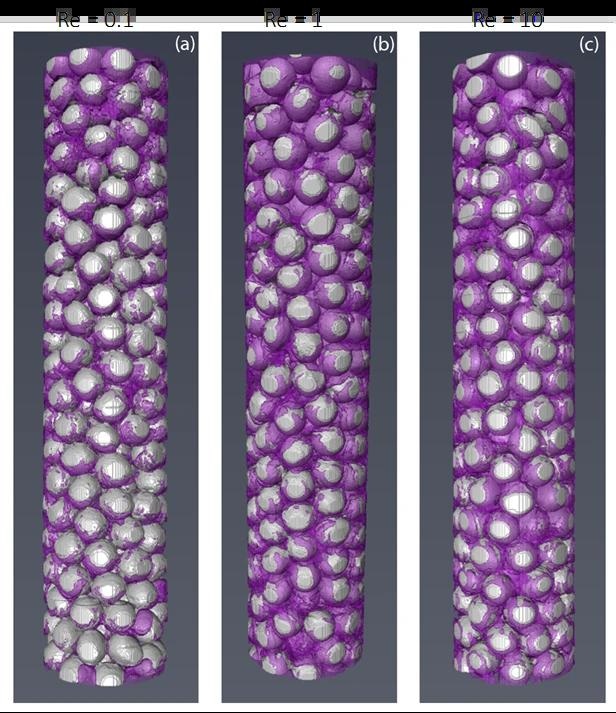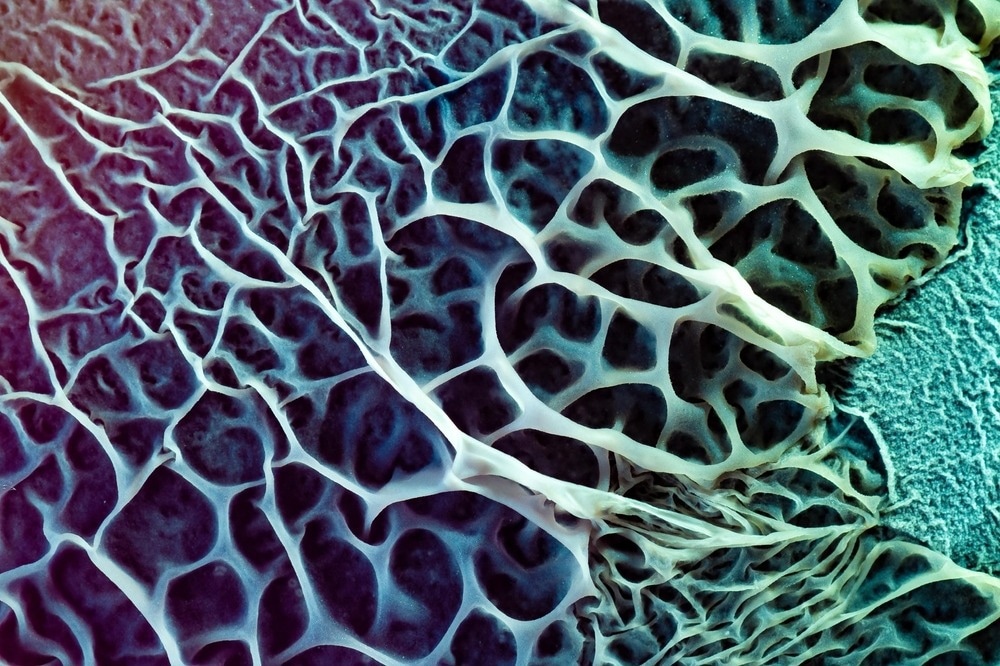Reviewed by Danielle Ellis, B.Sc.Nov 21 2023
Two faculty members affiliated with the College of Engineering at Oregon State University have teamed up with NASA for a National Science Foundation project valued at $525,000. The objective of the project is to explore the influence of gravity, or its absence, on microbial growth.
 X-Ray tomography-based 3D visualizations of microbial biofilm architecture and distribution in porous media columns. The experiments represent three different flow rates, varying three orders of magnitude (slowest on the left, fastest on the right). The glass beads (representing a simplified version of a groundwater aquifer material) are gray, and the biofilm is purple. Image Credit: Dorthe Wildenschild, OSU College of Engineering.
X-Ray tomography-based 3D visualizations of microbial biofilm architecture and distribution in porous media columns. The experiments represent three different flow rates, varying three orders of magnitude (slowest on the left, fastest on the right). The glass beads (representing a simplified version of a groundwater aquifer material) are gray, and the biofilm is purple. Image Credit: Dorthe Wildenschild, OSU College of Engineering.
Dorthe Wildenschild and Tala Navab-Daneshmand intend to send specimens to the International Space Station to study the formation of biofilms—aggregates of microorganisms adhering to each other and surfaces—in “partially and variably water-saturated porous media.”
In this particular investigation, they will analyze damp soil and rocks characterized by uneven water distribution, creating challenges for microbes to consistently access water.
Wildenschild emphasizes that comprehending biofilm formation in porous media has societal implications on Earth, spanning diverse fields such as groundwater remediation, water treatment, soil science, and agriculture. Moreover, biofilms play a significant role in the fouling of mechanical and medical devices, including implants.
The knowledge gained from studying biofilms in microgravity has the potential to deepen our understanding of altered microbial behavior in space, influencing engineered systems and human health during crewed spaceflights, as underscored by Wildenschild.

Image Credit: luchschenF/Shutterstock.com
The environmental engineering researchers plan to launch the OSU samples to the space station via a space shuttle in late summer 2025. They envision involving astronauts in the process and actively communicating some of the activities conducted on the samples as part of STEM outreach events at the Oregon State campus.
We don’t know yet when we will be offered a spot on a space freighter, but we will likely need more than a year and a half to prep for sending the samples up and preparing the highly detailed protocols for the astronauts."
Dorthe Wildenschild, Oregon State University
The project will specifically focus on examining the interplay between capillarity and gravitational forces in the context of microbial growth. Capillarity, influenced in part by the surface tension of a liquid, is a phenomenon where a liquid spontaneously moves up or down in a narrow space, such as a thin tube or the voids of a porous material.
The researchers aim to understand the role of capillarity in the development and evolution of biofilms into three-dimensional structures within pore spaces. While gravity also contributes to this growth and evolution, on Earth, it is not possible to deactivate gravity to isolate and study solely the influence of capillarity.
We’re sending the samples to space to eliminate gravity so we can better understand the interplay between gravity and capillarity, and how each of these forces affect biofilm growth and architecture."
Dorthe Wildenschild, Oregon State University
Wildenschild added, “The research conducted on the ISS will also provide opportunities to explore 3D objects when the samples are microCT scanned upon return to Earth to allow for comparison between biofilms grown in the presence or absence of gravity. The 3D scans will give viewers the feeling of flying through the object.”
The researchers posit that by considering the flow domain, which involves the interaction among capillary, gravitational, and viscous forces, they can anticipate the type of biofilm that will develop—whether it be compact, fluffy, patchy, and so forth. Viscosity, which influences a fluid's resistance to flow, is a key factor in this prediction.
We can control viscosity and by turning off gravity in space, we can compare the growth patterns to those obtained on earth and thereby tease out the role gravity versus capillarity plays in the formation of biofilms."
Dorthe Wildenschild, Oregon State University